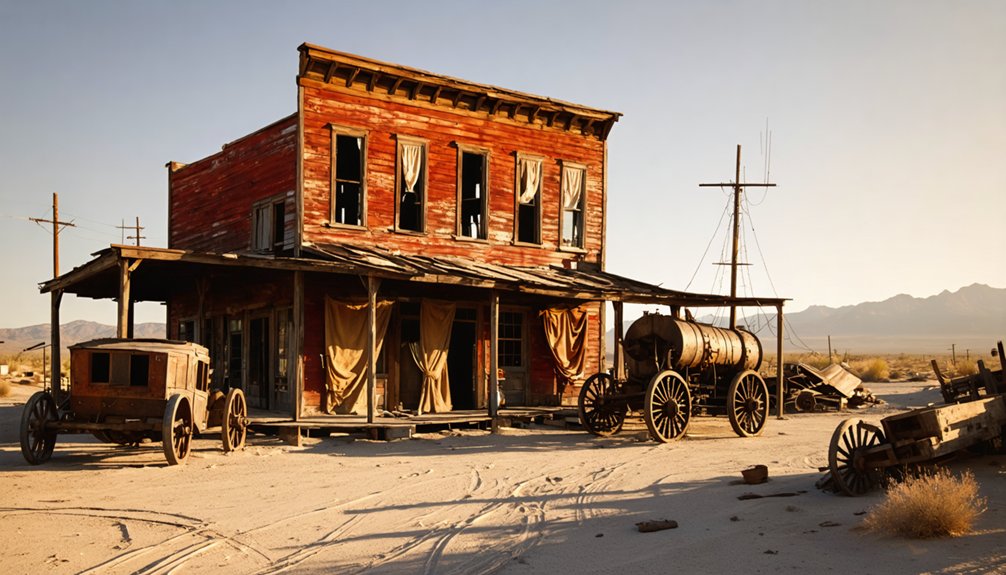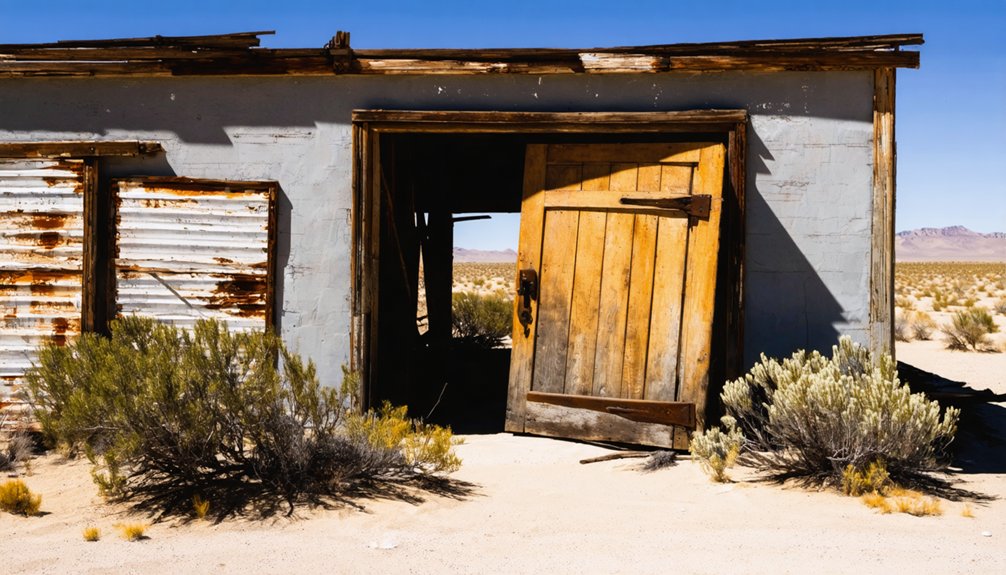You’ll find the ghost town of Atolia in California’s Mojave Desert, where a 1904 tungsten discovery sparked an incredible mining boom. By 1916, it became the world’s largest tungsten producer, with over 2,000 residents enjoying four restaurants, three stores, and the infamous “Bucket of Blood” saloon. After World War I’s tungsten demand crashed, the town’s fortune evaporated. Today, Atolia’s crumbling ruins tell a fascinating tale of strategic mineral wealth, international intrigue, and desert prosperity.
Key Takeaways
- Atolia was California’s premier tungsten mining boomtown, producing 90% of America’s tungsten from 1905 through the mid-1900s.
- The town peaked during World War I with 2,000 residents, four restaurants, three general stores, and the famous Bucket of Blood Saloon.
- Mining operations generated nearly $10 million in tungsten ore between 1916-1918, making Atolia the world’s largest tungsten producer.
- Post-World War I tungsten price crashes devastated the town’s economy, leading to widespread closures and population decline.
- The town became abandoned by 1922 when essential services shut down, transforming the once-bustling mining community into a ghost town.
The Discovery of Tungsten in the Mojave Desert
While prospectors Charles Taylor and Tom McCarthy were initially searching for gold in the Mojave Desert around 1903-1904, they stumbled upon what would become America’s most significant tungsten discovery.
At the Yellow Aster mill, they encountered a peculiar white, heavy mineral that complicated their gold mining techniques. This “heavy spar,” later identified as scheelite, would transform the region’s mining focus. The deposits formed through hydrothermal solutions seeping through fault fissures.
A chance encounter with mysterious white scheelite at Yellow Aster mill derailed gold mining plans but unveiled greater riches ahead.
The timing couldn’t have been better – industrial demand for tungsten’s unique properties in steel hardening was soaring. By 1905, just south of Randsburg, California’s first tungsten camp emerged in Atolia. Located at an elevation of 5,161 feet, the mine would become a crucial source of this valuable mineral.
You’ll find it remarkable that this accidental discovery led to the establishment of North America’s richest tungsten district, producing an astounding 90% of America’s tungsten over the next five decades.
Birth of a Mining Boomtown
After discovering substantial tungsten deposits in 1904-1905, the Atolia mining settlement rapidly transformed from an empty stretch of Mojave Desert into a bustling boomtown.
With advanced mining technology and efficient community governance, you’d have found a well-planned town sprouting around the central tungsten mill built by Atkins and DeGolia in 1907.
The town’s population surged as the Papoose Mine dominated global scheelite production between 1908-1911. By 1916, Atolia had become the largest tungsten producer in the world.
You could’ve witnessed the town’s incredible growth through:
- A booming workforce earning $60,000 monthly in payroll during peak operations
- Essential infrastructure including restaurants, stores, and a 60-student school
- Cultural amenities like pool halls and a movie theater
- The establishment of the *Atolia News* weekly paper in 1916
World War I and Strategic Importance
You’ll find that Atolia’s tungsten mines played a vital strategic role during World War I, as the metal was essential for hardening steel used in military weapons and armor-piercing shells.
The town’s mines became the world’s largest tungsten producer between 1916-1918, generating nearly $10 million in ore that supported both Allied and Central Powers.
Even German U-boats made clandestine runs to transport Atolia’s valuable tungsten despite naval blockades, highlighting the metal’s strategic importance in the global war effort.
The bustling mining town reached a population over 2,000 during its peak wartime operations.
The company paid its workers a remarkable monthly payroll of $60,000 during the town’s most prosperous period.
Tungsten’s Critical War Role
During World War I, tungsten emerged as an essential strategic metal that revolutionized military capabilities. The metal’s unique properties transformed mining technology and industrial applications, becoming indispensable for America’s wartime production.
You’ll find that tungsten’s importance grew rapidly as manufacturers discovered its significant role in:
- Hardening steel for armor-piercing shells and bullets
- Creating high-speed cutting tools for weapons manufacturing
- Producing filaments for military searchlights and communication equipment
- Strengthening tank armor and aircraft components
The demand for tungsten sparked intense mining activity in Atolia, making it a critical hub for the war effort. German military forces demonstrated tungsten’s effectiveness when their tungsten carbide shells proved devastating against enemy tanks. U.S. tungsten prices experienced an unprecedented surge from $750 in 1913 to peak wartime values of $10,000.
As one of the nation’s primary tungsten sources, the town’s mines operated around the clock, employing advanced extraction methods to meet the military’s urgent requirements. This period marked Atolia’s peak as a strategic resource center.
Global Supply Chain Impact
While World War I transformed many mining towns, Atolia emerged as a global powerhouse in the international tungsten trade.
You’ll find it fascinating how this remote California town became central to the global supply chain, shipping critical tungsten to both Allied and Central Powers before America’s war entry.
When Germany’s access to tungsten was cut off by England’s naval blockade, they went to extraordinary lengths – even sending cargo submarines like the Deutschland to Baltimore to secure Atolia’s output.
The town’s strategic importance can’t be overstated. Atolia’s tungsten production, reaching nearly $10 million between 1916-1918, directly influenced military capabilities worldwide.
The precious mineral, indispensable for hardening steel, became so valuable that shipments required guards during transport via the Randsburg Railway to coastal ports, highlighting the intense competition for control of this essential resource.
At its peak, the bustling mining town supported a population of two thousand residents, complete with restaurants and even a movie theater.
Life in a Bustling Desert Community
During Atolia’s peak years, you’d find over 2,000 residents pursuing the daily rhythm of desert mining life, with miners heading to the tungsten mines while their families kept the community running.
When the workday ended, you could join other residents at one of four restaurants for a hot meal or head to the iconic Bucket of Blood Saloon for drinks and camaraderie.
The town’s movie theater provided welcome entertainment for the whole community, offering respite from the harsh desert conditions and demanding work schedules.
Daily Desert Mining Life
At the height of Atolia’s mining boom, nearly 2,000 residents carved out a life in this bustling desert community, supported by a robust infrastructure of four restaurants, three general stores, and a dairy that kept the town well-supplied.
Despite mining challenges, you’d find a tight-knit community showing remarkable resilience in the harsh Mojave Desert environment.
During World War I, the mines reached their peak production as Atolia became the world’s largest tungsten producer.
Your daily life in Atolia would’ve revolved around:
- Working long shifts in the tungsten mines or supporting businesses
- Living in basic housing, from simple cabins to boarding houses
- Dealing with extreme desert temperatures and limited water supplies
- Relying on the Randsburg Railway for essential goods and ore transport
The community’s spirit remained strong as residents banded together, sharing resources and supporting each other through the boom-and-bust cycles of desert mining life.
Entertainment After Dark Hours
The hardworking miners of Atolia didn’t just toil away their nights after long shifts in the tungsten mines – they embraced a vibrant nightlife that rivaled any desert town of its era.
You’d find yourself swept up in the excitement at the infamous “Bucket of Blood” saloon, where gambling games used tungsten ore as stakes and music from Los Angeles bands played through the night.
The town’s movie theater and multiple saloons kept you entertained, while the Randsburg Railway brought fresh faces and performers from beyond the desert.
Those seeking nightlife nostalgia would’ve loved the community dances and late-night shopping, though sheriff’s raids occasionally disrupted the gambling scene.
These saloon stories faded after WWII as the mining industry declined, leaving only memories of Atolia’s once-bustling after-dark entertainment.
The Deutschland Connection

While most Americans remained unaware of their small desert town’s global significance, Atolia’s tungsten miners played a pivotal role in Germany’s wartime efforts through a remarkable connection to the merchant submarine Deutschland.
This innovative submarine, designed to break through British naval blockades, created a secret supply line for Atolia’s strategic mineral resources.
The wartime logistics of getting tungsten from California’s desert to German factories involved:
- Heavily guarded rail transport via Randsburg Railway
- Secretive movements through Baltimore’s port facilities
- Submarine cargo loading under cover of darkness
- Carefully timed Atlantic crossings to avoid British patrols
You’ll find it fascinating that the Deutschland successfully delivered multiple shipments of Atolia’s tungsten to Germany in 1916, helping sustain their war machine despite the Allied blockade.
Economic Peak and Daily Operations
Beyond its wartime connections, Atolia’s meteoric rise as a mining powerhouse transformed this slice of California desert into a bustling community of 2,000 residents.
The town’s economic growth kicked into high gear when the Atolia Mining Company, backed by financier Bernard Baruch, began large-scale tungsten operations in 1906.
You’d find a well-organized operation that tackled daily mining challenges head-on. After Tom McCarthy’s discovery of a 40-pound tungsten ore chunk, the company built a processing mill and established efficient extraction methods.
The discovery of massive tungsten deposits spurred rapid development, with the company swiftly constructing mills and perfecting mining techniques.
The precious tungsten concentrate was so valuable it required armed guards during railway transport. The town hummed with activity, supporting four restaurants, three general stores, and even its own newspaper, the Atolia News.
Workers could grab a drink at the infamous Bucket of Blood Saloon after their shifts.
From Prosperity to Ghost Town

As World War I drew to a close in 1918, Atolia’s prosperous era came to an abrupt end when tungsten prices plummeted, devastating the town’s mining-based economy. The economic fluctuations tied to wartime demand proved detrimental, leading to widespread abandonment and the closure of essential services like the post office by 1922.
While mining operations saw brief revivals, particularly during the mid-1920s and World War II, they couldn’t restore the town’s former vibrancy.
Four key factors sealed Atolia’s fate:
- Loss of German tungsten markets due to wartime trade disruptions
- Shift from underground mining to mechanized open-pit operations
- Depletion of high-grade ore deposits
- Competition from nearby silver mining operations
Despite generating over $3 million in ore sales between 1923-1939, advances in mining technology and unstable markets ultimately transformed Atolia into a ghost town.
Frequently Asked Questions
Why Was Tungsten Initially Considered a Nuisance by Gold Miners?
In the 1890s, you’d find tungsten properties made gold recovery 30% less efficient. Its heavy weight and similar concentration patterns created mining challenges when separating gold from unwanted scheelite deposits.
What Happened to the Bucket of Blood Saloon Building?
You’ll find the Bucket’s history is sadly unclear, though local saloon legends suggest it fell into disrepair and ruin as Atolia declined after WWI, joining other abandoned structures in the ghost town.
How Deep Were the Tungsten Mines in Atolia?
You’d find these tungsten mines reached astronomical depths, with the Union mine plunging 1,021 feet deep, while most other shafts averaged 300 feet or less using traditional mining techniques.
Did Any Original Atolia Mining Equipment Survive to Present Day?
You’ll find very few surviving historic artifacts from Atolia’s mining era. Most original mining machinery has deteriorated or vanished, though you can still spot some old timbers and slusher ramp remnants.
Were There Any Major Accidents or Disasters in Atolia’s Mines?
Despite Atolia’s peak workforce of 2,000 miners pre-WWI, you won’t find major accidents in historical records. Mine safety reports show no documented disasters, though standard mining hazards existed in daily operations.
References
- https://nvtami.com/2024/06/04/ghost-towns-and-german-u-boats/
- https://en.wikipedia.org/wiki/Atolia
- https://www.destination4x4.com/atolia-san-bernardino-california-ghost-town/
- https://www.exploratography.com/blog-cal/2paby382jd9spqrtp3u1gg1ks4t9jc
- https://kids.kiddle.co/Atolia
- http://explorehistoricalif.com/ehc_legacy/nov2014.html
- https://digital-desert.com/a/atolia/
- https://www.publiclandsforthepeople.org/wp-content/uploads/2015/06/Desert-Fever-History-of-Mining-in-the-CDCA.pdf
- https://www.nps.gov/moja/learn/historyculture/mining.htm
- https://www.geologyforinvestors.com/great-deposits-the-atolia-district-tungsten-mines-california/



